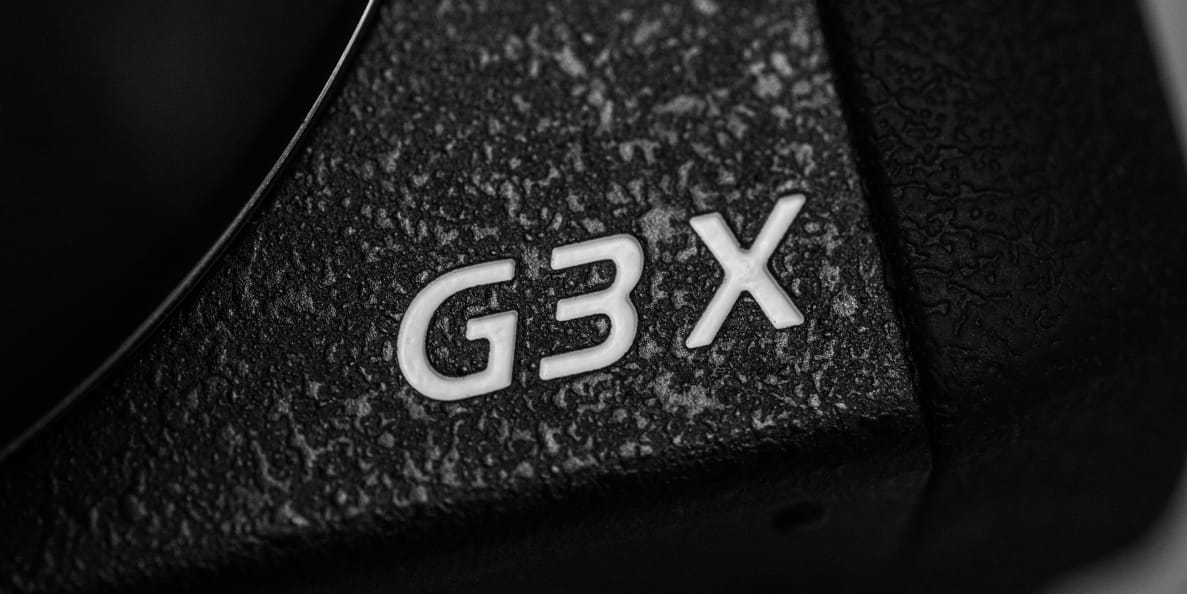Pros
-
Compact
-
Great for any skill level
Cons
-
Not great in low-light
-
Autofocus is lacking
But if you thought Canon would just cede the point-and-shoot crown to Sony and Panasonic, you're in for a surprise. Enter: the Canon PowerShot G3 X (MSRP $999.99), a camera built to compete with the very best point-and-shoots on the market. Like its competition Canon is also opting for a 1-inch sensor, a wide maximum aperture, lots of manual control, and even a weather-resistant body. Best of all, Canon outdoes both in the zoom department, with a whopping 25x ratio.
It's a solid resume, to be sure, but our lab tests indicate Canon had to make a few sacrifices to get there. And with the G3 X retailing for nearly $1,000 right now, sacrifice may not be what most shoppers want to hear.
Design & Handling
Bridging the gap between superzoom and premium point-and-shoot
At first glance, this camera looks just like any other somewhat blocky bridge camera—a term that indicates it "bridges" the gap between compact point-and-shoots and low-end interchangeable lens cameras. The chunky grip serves well to keep the G3 X stable in your hands, while the lens protruding from the rectangular body dominates the front of the camera. A very smooth control ring around the lens allows you to focus manually at a whim, but it doesn't control zoom.{{amazon name="Canon PowerShot G3 X Digital Camera", asin="B00ZM1E46I", align="right"}}
To accomplish that, you'll need to use the zoom slider positioned around the shutter release on the top of the camera. While up there, you'll notice that many of the controls are the same type of manual knobs and wheels that you'd normally find on older G-series cameras. Not to worry if you're a newer shooter, though—there are plenty of auto modes and user-friendly controls to help keep it simple.
{{ photo_gallery "tour" }}
Inside the body is a 1-inch, 20.2-megapixel sensor backed up by a Digic 6 processor, with 5-axis optical image stabilization, WiFi, and an NFC chip. However, the defining feature of this camera is the 24-600mm (full-frame equivalent) f/2.8-5.6 25x zoom lens. It has longer telephoto reach than its closest competitors, the Sony RX10 and the Panasonic FZ1000, which only reach 200mm and 400mm (full-frame equivalent) respectively. The tradeoff? An aperture that closes down to just f/5.6 through most of the zoom range. This lets in less light than its competitors, hindering low light image quality as you zoom in.
Another key point of differentiation is the G3 X's dust- and water-resistant body. While Sony claims the RX10 can survive moisture, the Canon G3 X is built to withstand the elements as well as the Canon EOS 70D, according to Canon. That's huge. As far as high-end point and shoots go, that level of sealing is extremely rare, giving the G3 X a major leg up.
On the back, there's an articulating 3.2-inch 1,620k-dot LCD that can flip all the way up for selfies. It's a little difficult to accomplish these, given the camera's size and weight, but it's possible to get a great shot without too much fuss. You can also tilt it downward for shooting over crowds, but it doesn't tilt very far.

A 600mm (full-frame equivalent) zoom is nothing to scoff at.
Like most bridge cameras, the G3 X has a chunky grip with plenty to latch onto. I thought it could probably be even larger, but it gives you enough support to keep the camera steady. To help this I often found myself using my left hand to support the camera, as you would with a DSLR.
For video fans, there are also microphone and headphone jacks on the left of the camera, with an HDMI output on the right. While this isn't a pro-grade camera, it'll be compatible with a wide range of pro accessories, opening up your kit options immensely.
{{ photo_gallery "design" }}
Features
Loaded to the gills
Canon's G3 X is jam-packed with extras to meet users with a wide range of technological demands. After all, it's meant to be a more serious point-and-shoot, so it's no surprise that Canon would want to make sure its baby had all the toys it could ever want. WiFi, NFC, 5-axis image stabilization, water resistance, RAW shooting, a huge zoom range—you name it, the G3 X has it... except for a viewfinder.
While it's not a dealbreaker for many coming from a lesser point and shoot, a viewfinder makes certain types of photography—shooting on a bright day, for example—much, much easier. The screen is good, and the ability to tilt it up or down is helpful, but if it's bright out you'll struggle to frame and focus your shots accurately.
You can add an external viewfinder via the hotshoe, but it costs a whopping $300 on top of the G3 X's already steep price. The hot shoe has other benefits as well, like the ability to attach an external flash or LED array. Just be sure to err towards items that don't draw power, because that battery is tiny. Using the same NB-10L cell used in other point and shoots like the Canon SX50 HS, the G3 X rips through a charge in about 300 shots. While that's a respectable amount, you'll definitely want to carry a charged spare with you if you're on vacation.
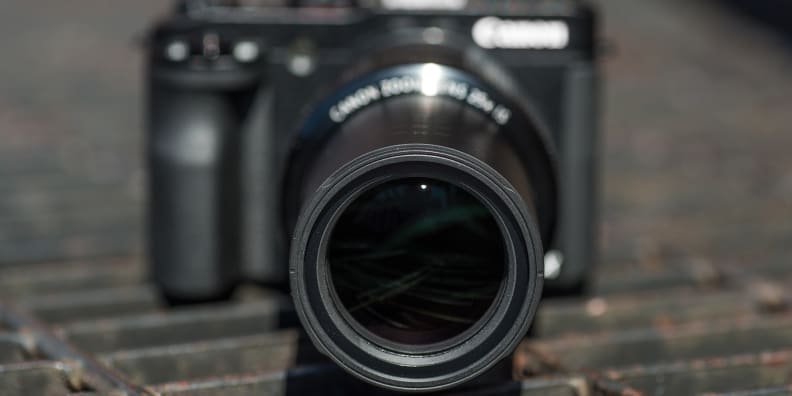
A long zoom is hindered by a narrow maximum aperture.
If you're interested in the G3 X for its zoom, it does have a really cool feature that will help you keep track of your subject. While shooting from far away, sometimes you can lose your target really easily. If you press the framing assist button on the side of the lens barrel the camera will zoom out briefly, showing you a white box on the rear screen. Just move the subject back inside this box and the camera will zoom back in to where you were.

A smooth control ring enables manual focus-by-wire.
It's a feature that has appeared on previous Canon superzoom cameras, and it's nice to see it on this camera. A 25x zoom is really nothing to sneeze at, and the fact that this lens is relatively compact and covers a 1-inch image sensor is an impressive technological feat. Unfortunately it does play havoc with the camera's ability to focus accurately on moving subjects, as it just isn't that quick to lock onto a subject. You can use tap-to-focus on the rear LCD, but we actually found manual focus was sometimes the best, making use of the large focus ring on the lens barrel.
Performance
Shoots fast and far, but it's a little soft.
Over the past couple years, the adoption of 1-inch sensors has dramatically improved the image quality amongst the top-end point-and-shoots. With the exception of a special few with even larger sensors, performance on cameras like the G3 X, RX10, and FZ1000 is top-notch when compared to the rest of the small-sensor crowd. For example, the superzoom Canon PowerShot SX60 HS might look the part of high-end camera, but it can't hold a candle to the 1-inch crowd.

Full-wide at left, full zoom at right.
As for reasons why that's the case, it all goes back to that sensor. A larger sensor means the camera can collect more light, meaning many of the problems (eg, diffraction, poor low light performance) introduced by the average point and shoot sensor are minimized. A smaller sensor is preferable when you want a lot of zoom, because you need smaller focal lengths (and thus smaller lenses) to be able to zoom in on subjects far away. The G3 X doesn't have a 50 or 60x zoom, but it does have a 1-inch sensor and respectable 25x zoom.
That large sensor did very well in most of our lab tests, with excellent color performance and white balance. It's is also capable of a respectable amount of dynamic range, showing decent highlight retention and shadow detail. The lens and sensor combo, however, isn't that great. The longer zoom is an incredible benefit, but your images become very soft once you zoom past the halfway point—even after Canon applies a healthy dose of oversharpening.

Sharpest shots happen when you're zoomed all the way out.
It's also worth reiterating that we had frustratingly bad autofocus issues at the telephoto end of the zoom range. And without a viewfinder, sometimes it's difficult to tell if your subject is actually in focus—especially if it's moving. When shooting on my own, I often walked away from a scene confident that I had nailed the shot, only to find out later that the autofocus hadn't quite gotten it right.
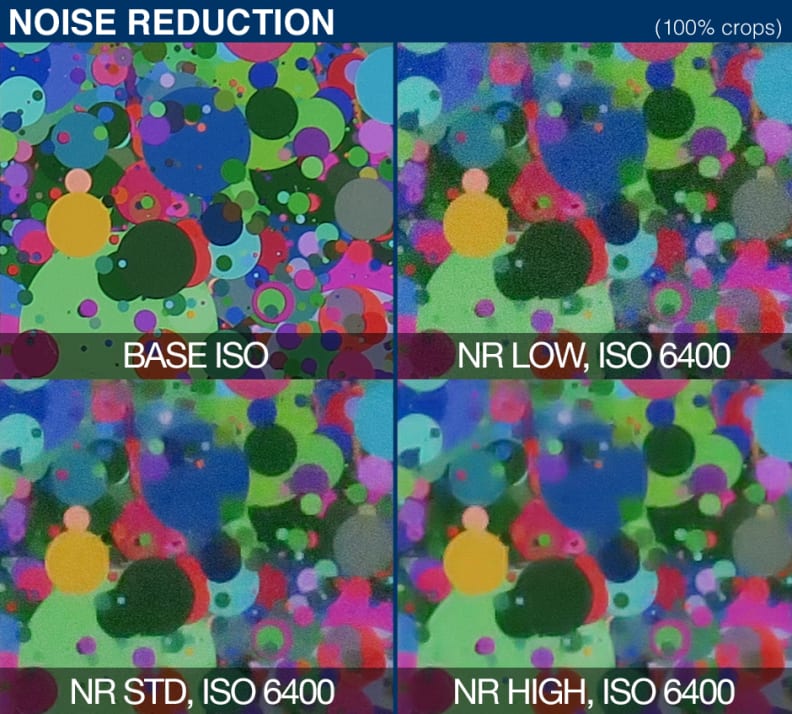
High NR destroys edge fidelity and fine detail.
The most surprising shortcoming of the Canon G3 X is noise. While it's true that it's far better than cameras with 1/2.3-inch sensors, among the 1-inch and larger crowd it's underwhelming. Even with default reduction setting, noise is clearly visible right at the base ISO, especially in areas of the scene without much fine detail, like blue skies. In low light, it hits the 2% threshold by ISO 6400, with fine detail breaking down well before that. There isn't much of a way around this except ramping up noise reduction in the camera or shooting in RAW and doing it later, sacrificing more fine detail in the process.
{{ photo_gallery "sample-photos" }}
Video performance—on the other hand—is great, though the G3 X doesn't offer niceties like 4K video. You can expect good-for-1080p sharpness in low light and bright, with very little artifacting or trailing even in high-frequency patterns. We recommend using the 60fps setting in the movie mode for best results—files will be much bigger, but the quality you get from them is superb for HD.
Conclusion
A great camera, but a tough sell
Nitpicking aside, the Canon G3 X is a camera that puts the bargain point and shoot crowd to shame. Like its older brothers the G1 X Mark II and the G7 X, the G3 X is a brawny point and shoot with a 1-inch sensor and advanced, DSLR-style controls. Add to that 5-axis image stabilization, RAW shooting, and weather sealing and you've got what looks like one hell of a camera.
However, at $1,000, it's what the G3 X doesn't have that concerns us. The lack of a viewfinder is downright puzzling, as it's not like the camera's all that compact to begin with. It does have a much longer zoom range than other 1-inch cameras, but there are still and video image quality tradeoffs that may also be tough to swallow with a camera this expensive.
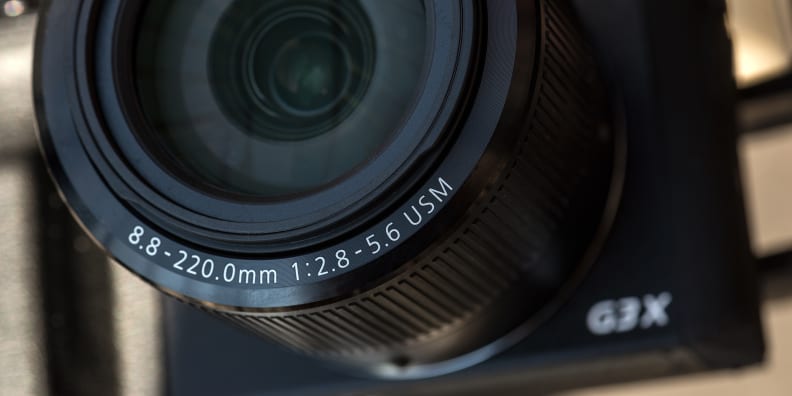
The G3 X has a somewhat limited maximum aperture at full zoom.
If you are merely looking for a camera with a lot of flexibility, we would recommend looking at the sub-$1,000 interchangeable lens camera market. Image quality is much higher, and you can always buy a long zoom lens later. For example: the Panasonic G7, Olympus OM-D E-M10, and Sony A6000 all offer much higher stills performance with a comparable budget. If you need help on buying lenses, don't worry: we've got you covered there too.
If you're set on a fixed-lens camera, the G3 X's closest competition is the Sony RX10 II (MSRP $1,299), the original Sony RX10 (MSRP $899), and the Panasonic FZ1000 (MSRP $799). All three offer a similar feature set, but they also include an electronic viewfinder and offer slightly better image quality. What they don't have is the G3 X's robust weather sealing and extensive optical zoom, as the RX10 series tops out at 8.3x while the FZ100 has just a 16x zoom lens.
And that's really the G3 X's saving grace: as expensive as it is relatively to the FZ1000, there just isn't a high-end point-and-shoot that offers this kind of zoom range. It doesn't have an EVF and the autofocus can be a real chore to work with, but for the right buyer—and hopefully at a slight discount—the G3 X is a solid buy.
By the Numbers
Looking solely at our lab performance, the story is quite good. The G3 X is a perfrectly solid camera with great color performance, decent sharpness, and good video quality. Really the only place there's a noticeable deficiency in quality is in noise performance—but part of that is simply because the camera can really push its ISO speeds really high. We did not penalize the camera for that.
Color and White Balance
As Canon cameras are wont to do, the G3 X has excellent color accuracy and white balance. With a ∆C 00 (saturation corrected) color error of 1.95 and an overall saturation level of 113.7%, the G3 X boasts a near-perfect color error (perceptually speaking, anyway).
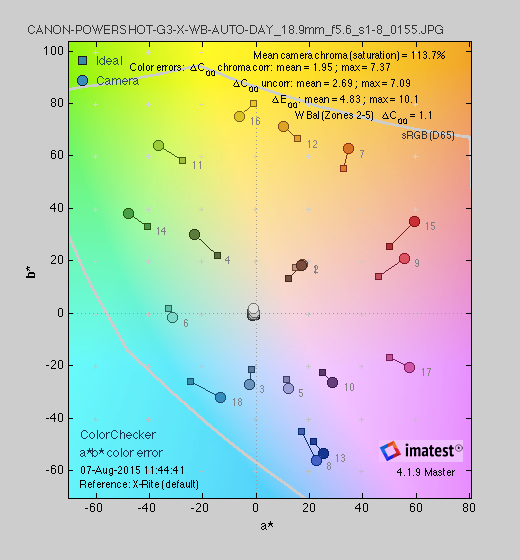
Colors are spot on, though a bit oversaturated.
Sticklers for perfect color will probably notice that somewhat elevated level of saturation, but no one color really gets boosted more than others. It's a very even saturation boost, which is uncommon—and worthy of praise.
White balance, too, is superb. With the notable exception of incandescent lighting (which will give your snaps a distinct orange tinge to the tune of 2000 kelvin), the automatic white balance will get shots taken in fluorescent lighting and daylight to within 150 kelvin of ideal—meaning only very slight coloration to your shots.
Sharpness
Sharpness is decent, but you're going to want to keep your zoom in check. Though the overall average sharpness across all focal lengths is about 1902 line widths per picture height, it's mostly due to the wide and middle focal lengths. Once you go past the midpoint, you'll notice a steep dropoff in sharpness—culminating in an MTF 50 measurement of around 1500 LW/PH at full zoom.
Additionally, the G3 X applies anywhere from 15-30% oversharpening in its JPEG processing to achieve these results. If you shoot in RAW, you'll probably wind up applying clarity boosts and the like to get more usable results.
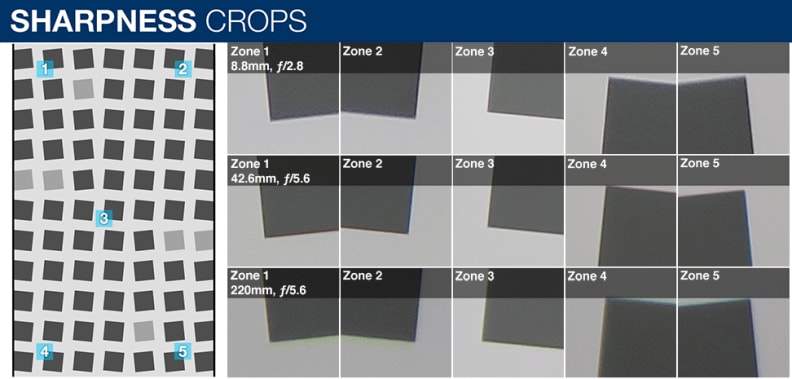
Chromatic aberration is present at most maximum apertures, as well as evidence of oversharpening.
If you go pixel-peeping, you'll probably notice some haloing in high-contrast edges. It's a normal thing for a camera to do with its default JPEG engine, so you're probably used to this already. No big deal.
Barrel distortion really isn't a problem, but you may or may not notice a bit of chromatic aberration in your shots. It's a common thing for sub-$1000 cameras (and lenses ) to have.
Noise
Here's where things get messy. The Canon G3 X has a noise problem, and it's not something that's easily ignored. Long story short, you will be forced to make tradeoffs with the noise reduction settings, and they're a doozy.

High NR destroys edge fidelity and fine detail.
So for starters, the default NR setting is "Standard," which is the best mix of detail retention and noise reduction you can get on this camera. If you set it to "Low," you'll notice appreciable grain in your shots from ISO 800 and up, and if you set it to "High," you'll notice fine details are removed with prejudice.
Using default settings, you can pretty much expect your shots to be usable all from base ISO all the way through ISO 3200. Beyond that, and you'll have a very visible 2+% chroma and luma noise.
Video
Video is a strong suit for the Canon G3 X, with high (for 1080p) sharpness, low artifacting, and 60fps HD recording. If there's one thing this camera does extremely well, it's record things in bright light.
Though there's no 4K shooting, the 1080p modes perform well. In our labs, the G3 X recorded 600 line pairs per picture height in motion, while that number drops to 500 in low light (60 lux). While that's not going to blow the doors off the joint, keep in mind this isn't a system camera with a huge sensor, so expectations should be tempered accordingly.
If you're thinking about shooting in lots of low-light situations (birthday parties, etc), the G3 X is able to produce a 50 IRE image with only 6 lux of ambient light. That's pretty good considering the G3 X has a 1-inch sensor and not an APS-C or full-frame chip. Just don't expect any miracles and you'll be fine.
Meet the tester
A seasoned writer and professional photographer, Chris reviews cameras, headphones, smartphones, laptops, and lenses. Educated in Political Science and Linguistics, Chris can often be found building a robot army, snowboarding, or getting ink.
Checking our work.
Our team is here for one purpose: to help you buy the best stuff and love what you own. Our writers, editors, and lab technicians obsess over the products we cover to make sure you're confident and satisfied. Have a different opinion about something we recommend? Email us and we'll compare notes.
Shoot us an email

